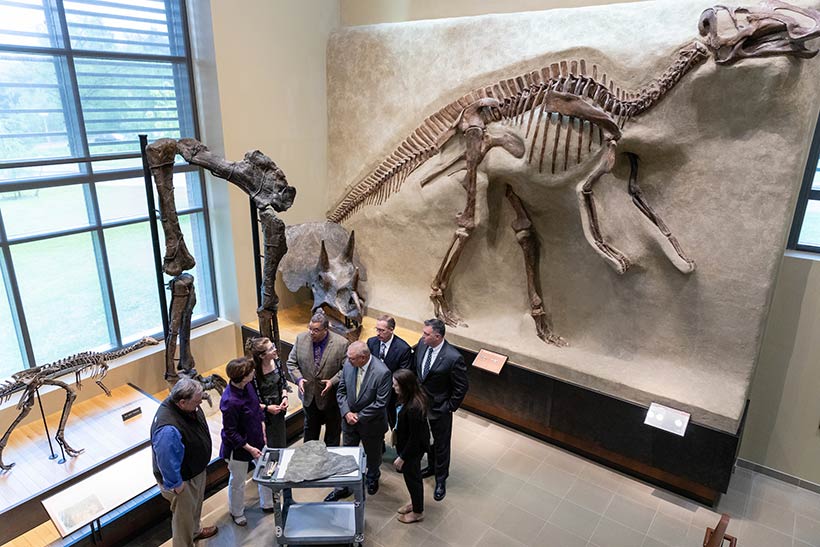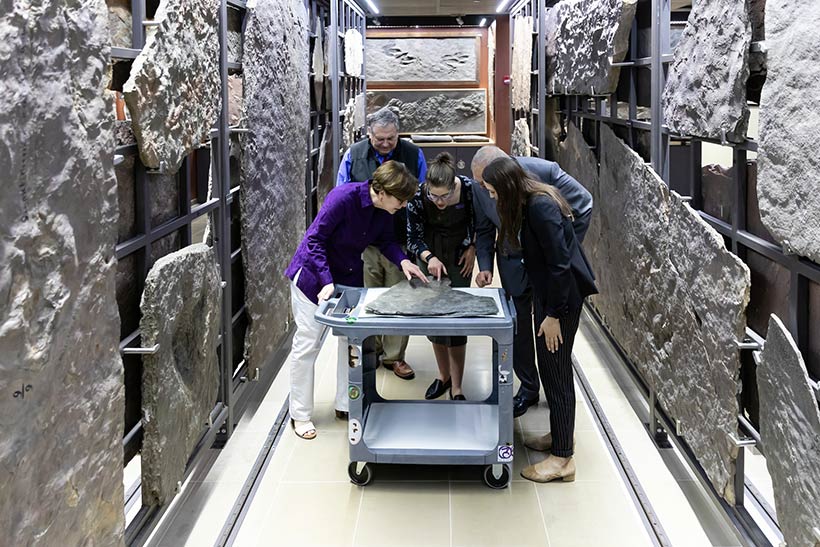It had all the elements of a heist movie: A (pre)historic treasure. A robbery that took place under a veil of darkness. The arrest of two thieves. The recovery of the stolen object.
But in this case, the crime didn’t involve rare gems or a Van Gogh painting—it involved a set of well-preserved dinosaur footprints that is now safely in the permanent possession of Amherst College’s Beneski Museum of Natural History.
The confiscated trackway, as it is called, was donated to the museum by the state Environmental Police on May 23.
“This is a great day,” said Massachusetts Professor in Chemistry and Natural History Tekla Harms, chair of the geology department and co-director of the museum, during an impromptu handover “ceremony” in the museum’s Wolansky Gallery, which houses the Hitchcock Ichnology Collection. She noted that the fossilized footprints will be studied by paleontologists for years to come. “It’s gratifying to have a happy ending to this story.”
In 2002, two poachers hammered away at a shale ledge in Gill, Mass., likely for hours, to break off the 14-by 9-inch trackway. The thieves were apprehended by a town police officer who had seen them climbing an embankment with heavy duffels; the officer then discovered the rocks in the bags when he searched them. One of the men initially told the authorities that he and his partner were gathering rocks to make a fireplace, but then later confessed that the plan was to sell the footprints on eBay.

The theft of a trackway in Massachusetts is certainly not common, but not unheard of either, since there are no legal safeguards for rocks with dinosaur footprints specifically, explained Environmental Police Lt. Col. Anthony Abdal-Khabir. In this case, for example, the poachers could be charged only with trespassing and “theft of stone,” an act that was officially made a crime in colonial times. As a result, the proceeds of the sale of a pilfered trackway far exceed the fines incurred for being caught stealing it.
Clearly, the disappearance of such fossils is devastating in and of itself, said Harms. But not being able to study them in their natural context is also a scientific loss, since valuable information about the makers of the footprints—such as the ecosystem in which they lived, their migration patterns and the speed at which they moved—is contained in the surrounding rock material and in longer, continuous trackways.
That information can also contribute more broadly to the body of knowledge about evolution and, by extension, humanity, added Hayley Singleton, head of collections and operations at the Beneski. “The public needs to be aware that people are taking resources that belong to—and are about—them.”
According to Singleton, the recovered trackway is categorized as a Eubrontes (this is the name of the footprint, which is identified by its shape, not the creature that made it) and is estimated to be 190 million years old. While she and her colleagues know the footprints were made by a large theropod dinosaur, “exactly what specific species made these tracks remains a mystery,” she said, because almost no dinosaur skeletal material has been found with such trackways. In the Jurassic period, the conditions in Gill and the Connecticut River Valley, in general, were ideal for preserving footprints, but not conducive to fossilizing bone.

In the years since the Eubrontes was used as evidence in the criminal case against the poachers, the trackway remained in the safekeeping of the authorities. Abdal-Khabir decided in recent months to find an appropriate home for the footprints.
The Beneski seemed like the perfect place because of its reputation and mission, as well as its close proximity to the location where the trackway was found, he said. His team sent the museum photos of the slab in February and then arranged for the handover.
“We rarely have a situation like this,” said Abdal-Khabir of being able to donate such important evidence to a worthy organization. Giving the fossil to the Beneski “is in the best interest of the Commonwealth, where it can be viewed, researched and studied,” he added. “It was the right thing to do for the preservation of the specimen and the betterment of the community.”
